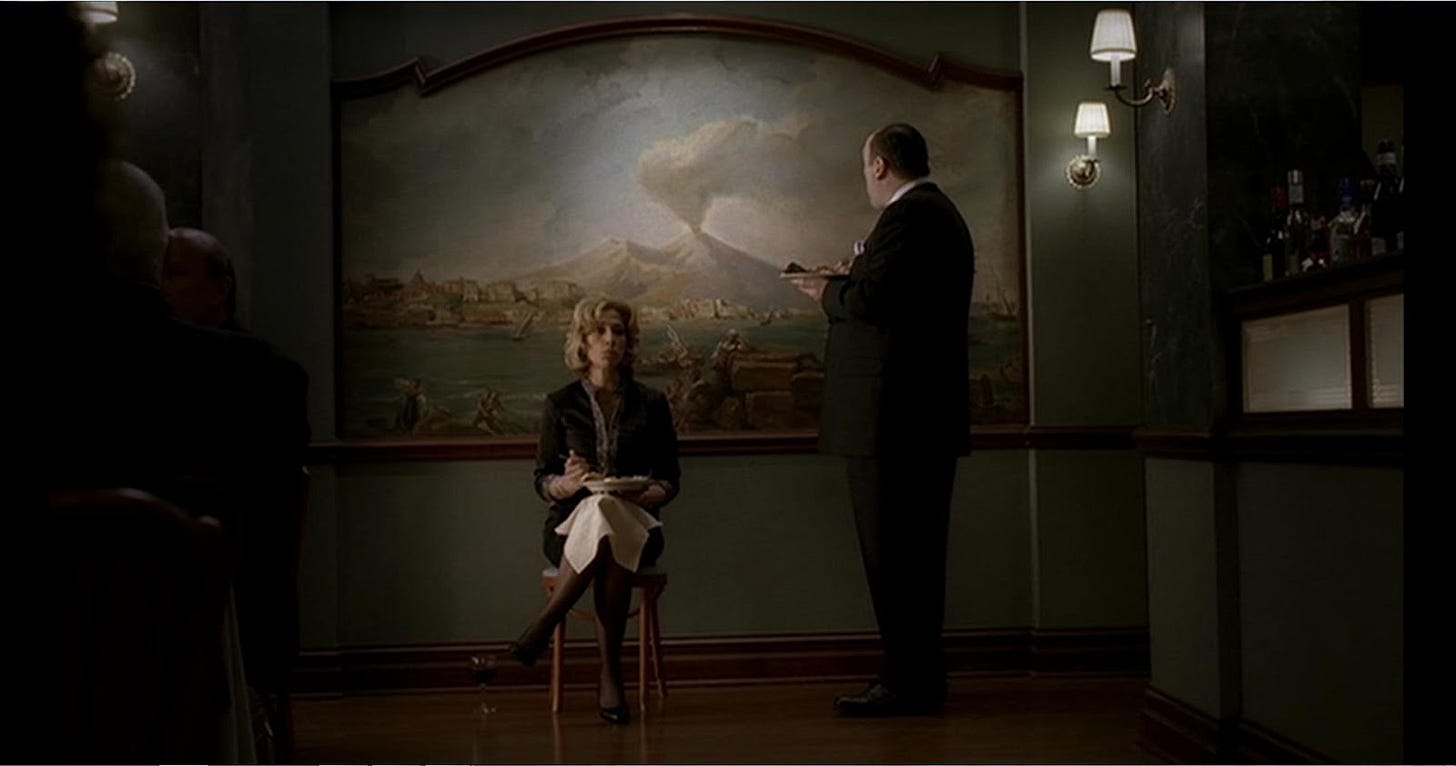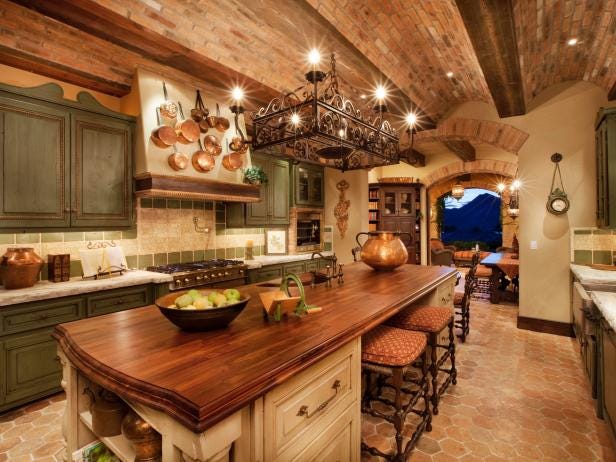There is an iconic shot in the Sopranos finale “Made In America” in which Tony gazes at a restaurant mural of Mt. Vesuvio at a funeral after-party, while his wife Carmela sits beside him, her back turned. The volcano is about to erupt, mirroring the unraveling of his criminal lifestyle.
Of course, this is no random volcano. It is Vesuvio: the defining landmark of Naples, the ancestral home of the Soprano lineage. Tony is gazing at his future, but also his past — the past that his grandparents fled in order to give their family a better life. In this moment (as in the pilot and the series at large), Tony is confronting the question: did I get a better life? Was the quest for the American Dream all worth it?
Importantly, Tony’s interest in this moment is provoked by no Botticelli painting. The mural is a clear example of Italian kitsch.
Kitsch usually gets a bad wrap, and rightfully so. It is artifice, facsimile, imitation. More than that, it is often tacky and tasteless.
Kitsch survives only on the coattails of embedded emotional or cultural preconceptions.
Clement Greenberg writes in his 1939 essay “Avant Garde and Kitsch”:
Kitsch is mechanical and operates by formulas. Kitsch is vicarious experience and faked sensations. … The precondition for kitsch, a condition without which kitsch would be impossible, is the availability close at hand of a fully matured cultural tradition, whose discoveries, acquisitions, and perfected self-consciousness kitsch can take advantage of for its own ends. … It draws its life blood, so to speak, from this reservoir of accumulated experience.
Kitsch arose in the late 19th-century, as industrialization allowed for the mass production of themed art and trinkets. Kitsch is like pornography in that you know it when you see it (among other similarities). It depicts a fantasy stripped of any nuance or complexity.
The fantasies that kitsch exploits can center around a variety of themes, both wholesome and not-so-wholesome: friendship, love, sex, power, sin, and opulence, among others.
And so, kitsch is snow globes, Hello Kitty, and Precious Moments figurines. On a larger scale, kitsch is Disneyland, Las Vegas, and perhaps half of the contemporary American architectural landscape (a McMansion with a large yard is arguably a simulacrum of a rural estate).
Some fantasies have an ethnic tinge. In the American mind, there is a fascination with Italy and all that it represents (tradition, community, simplicity, romance, and warmth). Naturally, then, Italian kitsch flourishes in homes and restaurants across the country.
Photo Courtesy of Steven Senne/AP
(The particular Vesuvio mural I mention is a relatively tasteful example of Italian kitsch — perhaps barely even kitsch. On the opposite extreme of the Italian kitsch spectrum would be anything you see at the Olive Garden).
The dominance of Italian kitsch in America has waxed and waned over the years. The 2000s may have been the peak. This decade saw an explosion of upper-middle class homes adopting the Tuscan style, with its various shades of brown and beige and its ostentatious, swirling patterns on chandeliers and furniture.
Photo Courtesy of HGTV
The appreciation of Italian kitsch by the non-Italian masses is simple enough to understand. It is the lust for the exotic, also exemplified in Japonism, Orientalism, and now #Traveltok.
What primarily interests me is the appreciation of Italian kitsch by Italian-Americans. In these cases, the consumers personally identify with the kitsch. The Italian fantasy, in their minds, is not merely a fantasy; it is a past reality. It is their imagined origin story; the Garden of Eden from which they were banished.
The backdrop of my childhood was the predominantly Italian-American stretches of 2000s suburban Central New Jersey. This region was then, and still is, a maze of Italian kitsch.
Most Central Jersey houses are still Tuscan-styled on the inside, as they were either constructed or went through their last major renovations 20 years ago. Their sprawling developments are interrupted by networks of strip malls, each with pizzerias and Italian fare.
I grew up accustomed to the sight of tan, faux-crumbling walls, dotted with stereotypical Italian chef statuettes and obnoxiously-brightly-colored paintings of the Venetian sun setting on gondoliers, while I ate Sicilian slices. I ingested this kitsch regularly for years, before I ever saw the real Italy it was loosely based upon.
Somewhat paradoxically, I have found that Italian kitsch is at its most gaudy and exaggerated among Italian-Americans, the ones who could most reasonably identify with it. In many WASP houses, Italian kitsch is a light motif (in the houses that still feature it at all, since most have since switched to a Millennial gray theme, in line with the trend cycle). In many Italian houses, it remains an oppressive, overarching theme.
Italian kitsch is simultaneously trashy and endearing. Part of me wants to reject it outright as an indictment on rootlessness and what it does to the aesthetic sense of the assimilated children of immigrants. But part of me finds it genuinely comforting, in a way that I hope extends beyond mere Stockholm Syndrome.
While I reject the isolated nature and cookie-cutter exteriors of my Central Jersey stomping grounds, I look back somewhat fondly upon the kitsch interiors that had welcomed me once I entered through most doorways. I even find them inspiring (maybe not in the way an art connoisseur is inspired by a Baroque painting, but in the way a parent is inspired by their child’s drawing before they hang it up on the fridge).
Some of the eccentricities of Italian kitsch can be justified when we examine the kitsch through the lens of Italian-American culture (a diverse, fascinating, and worthwhile culture in its own right, separate from both standard American culture and Euro-Italian culture). For example: the juxtaposition of northern and southern Italian landmarks may not make sense as a representation of Italy, where those regional cultures are rightly recognized as starkly distinct. But it does make sense for Italian-Americans, where descendants of all regions of Italy have now long intermingled and interbred.
But more substantially, I excuse Italian kitsch because it is the Italian-American community’s primitive way of reconnecting with something that had been lost.
The consumers of Italian kitsch often imagine the loss to be Italy; more likely, the loss is the Italian-American urban communities they fled in waves since the 1960s en route to the suburbs. The kitsch itself is inauthentic, but the impulse behind its display — the desire for connection with a tradition — is pure.
Perhaps the kitsch consumers just don’t have the distance to see that the Little Italys and Bensonhursts and Belmonts and North Ends that they and their families left behind are themselves links in the great chain of their tradition, more than the images depicted in modern Italian kitsch ever were.
Sometimes, I wish I never read a word about kitsch, or worse yet, camp. I fear that the concept of ironic appreciation has made me lose my ability to receive artworks earnestly. I find myself constantly deeming things so ugly that they are beautiful, or so false that they are true. I have lost my sense of up and down and now suffer from postmodern artistic vertigo.
After such knowledge, what forgiveness?
For this reason, I withhold judgment on whether or not kitsch, in its standard or Italian forms, is a blemish on the Earth that ought to be excised.
But I can discern with confidence the emotions underlying the appreciation of Italian kitsch: nostalgic yearning. Despite the contemporary amenities most Italian-Americans enjoy in atomized suburbia, there is a subconscious desire for something more. Wistfulness for the vibrant Italian-American communities of prior generations is eased with the saccharine comforts of kitsch. Fantasy Italy puts a bow on the Italian-American retreat from reality. It’s a sad situation, but I at least take hope in the fact that the nostalgic impulse is not yet dead and that the dream is still alive.
In the aforementioned Sopranos scene, Tony is transfixed by the volcano mural; he still finds the Italian idyll evocative. Though, in his distorted worldview, his mafia kingship is what secures his connection with the past and his quest for the idyll. Carmela is turned away. Unlike Tony, the idyll holds no more power over her.
Sometimes I doubt if the Italian-American community can ever feasibly be preserved or rebuilt. But I also suspect that it’s still possible as long as some people are still transfixed by Vesuvio.





"The Italian fantasy, in their minds, is not merely a fantasy; it is a past reality. It is their imagined origin story; the Garden of Eden from which they were banished." wow, that was an excellent line. I sent this article to a few friends, this writeup was really interesting.
Interesting. Reminds me of a Dr. Grumpy post from roughly 2011 where he criticized the overuse of the words "artisan" and "artisanal" in marketing campaigns. I'm not of Italian heritage or located anywhere near New Jersey, so I wasn't aware of the Tuscan style boom in the 2000s, but now I wonder if the "artisan" stuff was part of that.
https://drgrumpyinthehouse.blogspot.com/p/artisanal-overload.html